Hot glue is a versatile adhesive that has been popular among crafters and DIY enthusiasts for many years.
When it comes to the strength of hot glue, there are many questions, including; how strong is hot glue? Well, to answer that, hot glue can hold up to around 4-5 pounds in weight. However, the strength of hot glue depends on several factors, such as the type of hot glue, glue quality, surface, etc.
In this blog post, we’ll explore the strength of hot glue and put it to the test, as well as discuss the factors that may affect it.
Contents

5 Tests to Determine How Strong is Hot Glue:
Before we dive into the experiments, it’s essential to understand the different melting points of hot glues available. Generally, hot glue melts at 190–210 °C (374–410 °F). Low-temperature hot glue melts at around 250°F (121°C). High-temperature hot glue, on the other hand, can reach temperatures of up to 380°F (193°C).
The following experiments should be carried out with caution as they require dealing with items that may be dangerous if not handled properly.
Experiment 1: Testing Low-Temperature Hot Glue
To test the strength of low-temperature hot glue, apply a small amount to one end of a balsa wood stick and attach weight to the other end. Gradually increase the weight until the glue fails or the adhesion weakens.
You may conclude that low-temperature hot glue can hold up to 3 pounds (1.36 kg) before failing.
Experiment 2: Testing High-Temperature Hot Glue
In the next experiment, you can test the strength of high-temperature hot glue on a PVC pipe. Apply a small amount of hot glue to one end of the pipe and attach a weight to the other end, similar to the previous experiment.
Gradually increase the weight until the glue fails or the adhesion weakens. High-temperature hot glue can hold up to 8 pounds (3.63 kg) before weakening.
Experiment 3: Testing Hot Glue in Extreme Temperatures
To test the strength of hot glue in extreme temperatures, you can experiment with both high and low temperatures. Apply hot glue to a metal surface and allowed it to cool. Place the metal surface in a freezer for 24 hours and in an oven at 250°F (121°C) for 24 hours.
If the hot glue was still intact after being frozen and exposed to high temperatures, it is indicating that it can withstand extreme temperatures.
Experiment 4: Testing Hot Glue in Moisture
To test the strength of hot glue in moisture, apply hot glue to a piece of fabric and allowed it to dry. Soak the fabric in water for 24 hours and allowed it to air dry.
If the hot glue was still intact and able to hold the fabric together, it is indicating that it can withstand moisture.
Experiment 5: Testing Hot Glue in Tension
To test the strength of hot glue in tension, apply it to a piece of metal wire and allow it to dry. Attach a weight to the wire and gradually increase the weight until the glue fails or weakens.
You may conclude that the hot glue can hold up to 10 pounds (4.54 kg) before weakening, indicating that it can withstand tension.
Hot glue is a strong adhesive that can hold up against various materials, temperatures, moisture, and tension. However, it’s important to note that the strength of hot glue can vary depending on several factors.

5 Factors that May Affect the Strength of Hot Glue:
Besides the strength of hot glue, is also a convenient adhesive option. It dries quickly, which makes it ideal for projects that require a fast turnaround time. However, some factors can affect it;
1. Temperature:
Hot glue is called “hot” for a reason. It is applied at a high temperature to create a strong bond. However, if the temperature is too high or too low, it can affect the adhesive’s performance.
For example, if the glue is too hot, it may melt or weaken the material it’s bonding to. Conversely, if the glue is too cool, it may not bond as effectively.
2. Surface Texture:
The texture of the surface being bonded can also affect the strength of hot glue. Smooth surfaces, like glass or metal, may not provide enough surface area for the glue to adhere properly.
Conversely, rough or porous surfaces, like fabric or cardboard, can allow the glue to seep into the surface and create a stronger bond.
3. Clamp Time:
Hot glue bonds quickly, but it can take time for the adhesive to fully cure and reach its maximum strength. The amount of time required for curing, or “clamp time,” can vary depending on the temperature and humidity of the environment.
4. Type of Glue Gun:
Different types of hot glue guns may have different heating elements or output temperatures, which can affect the strength of the adhesive. Lower-quality glue guns may not heat up as quickly or maintain a consistent temperature, which can result in weaker bonds.
5. Type of Glue:
Different types of hot glue may have different ingredients or formulations that affect their strength and performance. For example, some types of hot glue may be more flexible, while others may be more rigid.
Tips to Improve the Strength of Hot Glue:
There are several tips you can use to improve the strength of hot glue.
- Follow the manufacturer’s recommended temperature range and allow the glue gun to fully heat up before use.
- Roughen up the smooth surface with sandpaper or a file to provide more surface area for the glue to adhere to.
- Follow the manufacturer’s recommended clamp time and avoid moving or manipulating the bonded materials until the adhesive has fully cured.
- Invest in a high-quality glue gun to ensure consistent and reliable adhesion.
- Choose the type of hot glue that best suits your project’s needs, and make sure to read the manufacturer’s instructions before use.
Conclusion:
In conclusion, hot glue is a strong and versatile adhesive option that can be used for a wide range of projects. It’s affordable, easy to use, and can withstand various environmental conditions.
However, it’s important to use the appropriate type of glue for your project and follow safety precautions when working with hot glue. By doing so, you can ensure a successful and safe project that will stand the test of time.

I fell in love with crafts & fixing things when I was 11 years old – after discovering the world of blogging, I am combining my passions to present the world with well-researched guides & reviews about everything related to adhesives & glue.